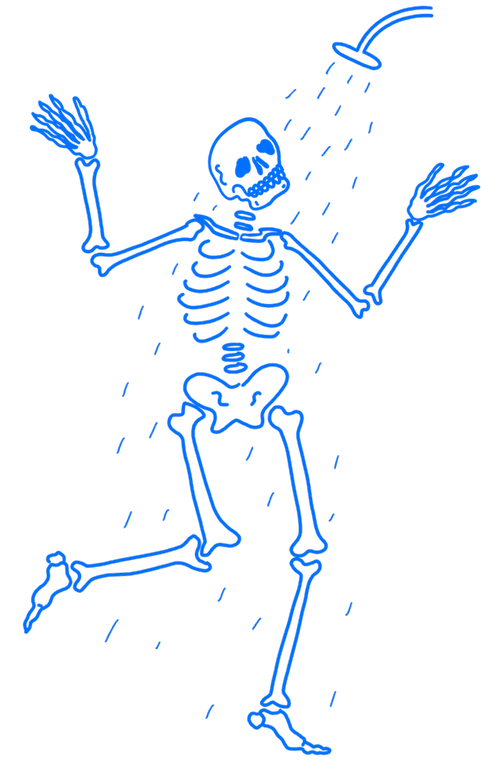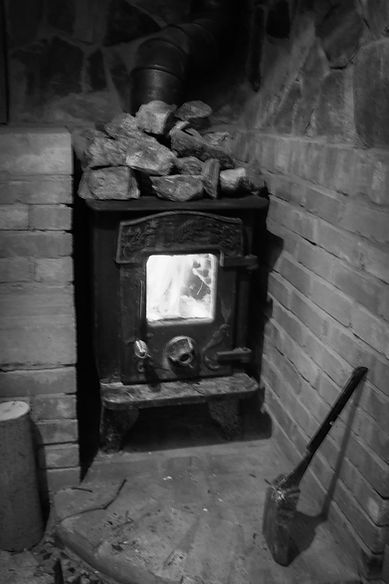
Tools for Longevity:
Sauna and Cold
We like to stay updated on research surrounding hot and cold. Feel free to get in touch about your experience, further reading, and ideas regarding how sauna and cold can be used to enhance health and create mental and physical well-being.
Hot
Heat has long been used for therapeutic, social, regenerative, spiritual, and business purposes. From Ancient Greek and Roman ‘Thermae’ to ‘Temazcal’ originating in Mesoamerica, the many variations of ‘sweat lodge’ used by Canadian First Nations, Scandinavian and European forms of Sauna, (Badstu, Bastu, Banya etc.), ‘Hammams’ of the Arab world, and many other derivatives varying culturally and topographically, societies have placed high value in spaces where people gather to feel heat, usually in commune with others.
There is something unique, powerful, and changing that happens when we alter our temperature homeostasis for a short duration, especially when punctuated with cold.
The simple concept of a small wooden room, a stove, and a few friends is extrapolated into the nuances: fire crackling, silent or intermittent conversation, sweat dropping, wafts of steam and thoughts of the impending cold.
Cold
Cold has also been used for millennia. Hippocrates recommended cold water to reduce fatigue and Thomas Jefferson took cold feet baths each morning. Scandinavians often combine cold ocean swimming with Sauna and Ukrainians celebrate epiphany by jumping into icy lake waters.
The cold is a refreshment, contrast, and antithesis to the heat, but also a powerful stimulant for internal body processes that result in profound changes in feeling and mood.
We move from stress response to a sense of calm, and finally to euphoric… in minutes.
At Snow Angel Hill we believe in progressive cold and offer many options for ‘cold time’ including ice cold showers, Snow Rolls, Snow Angels, and Ice Dips.
Be experimental and have fun but do so carefully as you build up tolerance to the cold.



Sauna
Over the last 50 years academics have investigated benefits of sauna on a variety of health parameters, particularly those associated with the cardiovascular system, mental balance, and physical well-being.
The famous Finnish Sauna Cohort Study followed the lives of a group 2315 middle aged men (42–60-year-old) and found that frequent saunas reduced the risk of Sudden cardiac death (SCD), coronary heart disease (CHD), cardiovascular disease (CVD) and all-cause mortality (Laukkanen et al., 2015). A 2018 review of “Cardiovascular and other health benefits of sauna” echoed similar findings and attributed cardiovascular benefits to reduced blood pressure, improved endothelial function, and reduction in oxidative stress and inflammation. The review also added reduced risk of neurocognitive and pulmonary diseases, improved immune system, reduced pain levels in those suffering rheumatic diseases, headache, and musculoskeletal disorders, and improved symptoms of those suffering from mild depression to the benefits of regular sauna use (Laukkanen, J., Laukkanen, T., Kunutsor, 2018).
A 2019 Study by Laukkanen and Kunutsor explored the evidence for reduced sudden cardiac death among sauna users, concluding that “…. sauna bathing appears to be linked to a remarkable array of CV benefits… The benefits of sauna bathing far outweigh the risks” (2019, p.10). The article also listed reduced risk of dementia, improved blood-lipid profile, and improved functioning of the autonomic nervous system as positive effects of regular sauna use.
Sauna has been likened to exercise, a positive stress, ‘eustress’, by which the body adapts and undergoes a variety of positive changes. There is a consensus that exercise in combination with sauna produces the strongest health benefits and there is significant overlap in how we ‘prescribe’ or ‘recommend’ using hot and cold and how we would approach an exercise program. Like exercise, adapting slowly is always the best way when learning to regulate temperature in the sauna. Try first tolerating the lower bench before going to the top bench where the temperature is hotter. Try shorter sessions if 15 minutes is too difficult at first. Longer term, and with repeated practice, the body learns to be more efficient at regulating temperature, making the process easier.
Typically, sauna sessions are arranged in 15-minute bouts because most people struggle to tolerate much more time (in an 80°-100° sauna), and also because health returns diminish after about 20 minutes and risk of overheating increases (Soberg, 2022). At Snow Angel Hill we keep our sessions to 15 minutes with a mandatory ‘cool-off’ period lasting from 10-15 minutes.
Cold Water
In water colder than 15° the ‘Cold Shock Response’ is activated, leading to a variety of physiological changes. Skin temperature receptors send messages to the brain activating the sympathetic nervous system. Vasoconstriction, tachycardia, and brown fat thermogenesis ensues as the bodies reacts to avoid hypothermia (Soberg, 2022).
At the same time a competing process called the “Diving Reflex” is also initiated. Baroreceptors sense water pressure against skin and activate the vagus nerve, turning the parasympathetic nervous system on (Knechtle et al., 2020). This results in lowered heart rate, decrease in arterial pressure, and other affects that serve to conserve oxygen and protect the inner organs. The competing processes, often referred to as ‘autonomous conflict’ (Knechtle et al, 2020) result in minimal changes in blood pressure, heart rate, and respiratory rates after the initial Cold Shock subsides (Soberg, 2022). Notably, the blood flow to the brain is also reduced during these processes by nearly 30% (2022), which can lead to feelings of drowsiness and blurred vision especially in those unconditioned.
So why voluntarily undergo this process?
A systemic review in 2012 concluded that Cold Water Immersion (CWI) is ‘effective at reducing perceived post-exercise muscle soreness’ (Tipton 2012). Cold temperatures combined with water pressure can help to reduce swelling by causing vasoconstriction, create pressure gradients, and increase fluid movement (Tipton, 2017). This explains why athletes have long used cold water as a recovery tool.
In addition to analgesic and rehabilitative properties, cold water also stimulates brown fat stores, which play an important role in metabolism, heat production, and insulin sensitivity (Soberg, 2022). Recently, they have been the focus of research in conditions such as Type II diabetes and obesity (Huo, 2022). Interestingly, the body seems to be able to adapt and grow more brown fat stores following exposure to cold water (Soberg, 2022). This can help to increase our metabolic engine and improve the ratio between brown and white fats in the body (Huo, 2022).
The elation experienced by ‘dippers’, winter-swimmers, and ice bathers, is likely due to spikes in endorphins, serotonin, and dopamine, all of which increase during the above processes. This high hits just minutes into the process and can last for much longer periods. Swimming in cold water has been used to treat depression, and ultimately has similar effects to regular exercise in release of norepinephrine and beta endorphins (Knechtle et al. 2020).
Hormones cortisol, adrenaline and noradrenaline are also present as part of the “fight or flight response”. This suggests that the process accrues some stress and needs to be carefully modulated. While there are studies linking CWI to improved immune function, Tipton et al. (2014), warn that repeated exposure to cold water constitutes ‘continued physiological stress’ that could even lead to immunosuppression (2014). Due to the possibility of drowning and hypothermia, caution is necessary while learning to ‘ice-dip’. Knechtle et al. recommend supervision during this process:
"Cold water swimming still poses a significant health risk for inexperienced and untrained swimmers. It is recommended that in order to fully benefit from the metabolic and thermogenic effects of cold-water swimming, a graded and progressive acclimatization program is required and preferably done under supervisor. "
(2020)
Like heat, cold constitutes a form of stress and can lead to adaptation. This process works like exercise, requiring a correct dosage and sufficient recovery. Adaptations to cold water exposure include metabolic acclimatization (an improved ability to warm the body and keep warm), decreased reactions to the ‘Cold Shock Response’ (more relaxed breathing and less stress on entry), and increased vasoconstriction (decreasing blood flow to skin and keeping core warmer) (Soberg, 2022). These changes make the process easier for adapted ‘dippers’ who use cold water as a powerful too to recover, super-charge metabolic processes, and experience the ‘high’ that keeps them coming back.
References
Cypess, A., et al. (2014). Brown Fat in Humans: Consensus Points and Experimental Guideline. Cell Metab. Sep 2;20(3): 408-415. https://pmc.ncbi.nlm.nih.gov/articles/PMC4155326/
Huo, C., et al. (2022). Effect of Acute Cold Exposure on Energy Metabolism and Activity of Brown Adipose Tissue in Humans: A Systemic Review and-Meta Analysis. Front Physiol. Jun 28 ;19 :917084. https://pmc.ncbi.nlm.nih.gov/articles/PMC9273773/
Knechtle et al. (2020). Cold Water Swimming- Benefits and Risks: A Narrative Review. Int. J. Environmental. Res. Public Health, 17(23), 8984. https://www.mdpi.com/1660-4601/17/23/8984
Laukkanen, J. A., Laukkanen, T., Kunutsor, S. (2018). Cardiovascular and Other Health Benefits of Sauna Bathing: A Review of Evidence. Mayo Clin Proc, Aug; 93(8):1111-1121. https://pubmed.ncbi.nlm.nih.gov/30077204/
Laukkanen, J. A., & Kunutsor, S. K. (2019). Is sauna bathing protective of sudden cardiac death? A review of the evidence. Progress in Cardiovascular Diseases, 62(3), 288-293. https://research-information.bris.ac.uk/ws/portalfiles/portal/193727584/Sauna_SCD_Final.pdf
Laukkanen, T. et al. (2015). Association between sauna bathing and fatal cardiovascular and all-cause mortality events. Jama Intern. Med, 175(4):542-8. https://pubmed.ncbi.nlm.nih.gov/25705824/
Laukkanen, T. et al. (2017). Sauna bathing is inversely associated with dementia and Alzheimer’s disease in middle-aged Finnish men. Age Ageing , Mar 1;46(2):245-249. https://pubmed.ncbi.nlm.nih.gov/27932366/
Soberg, S. (2022). Winter Swimming: The Nordic Way Towards a Healthier and Happier Life. MacLehose Press.
Tipton, M. J. et al. (2017). Cold water immersion: kill or cure? Experimental Physiology. Nov 1; 102(11): 1335-1355. https://physoc.onlinelibrary.wiley.com/doi/10.1113/EP086283




